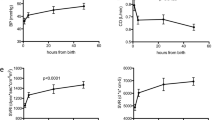Abstract
The design of a practical instrument for measurement of the value of the pre-ejection period (p.e.p.) of the cardiac cycle in real time is presented. This arrangement has the capability of determining the p.e.p. in the presence of relatively large amounts of biological-origin noise. A commercial Doppler ultrasound technique is used to obtain the aortic-valve velocity profile. An electrocardiographic (e.c.g.) trigger circuit provides a synchronising signal which is required to establish the beginning of the p.e.p. interval.
Sommaire
Les auteurs présentent un modèle d'instrument pratique permettant de mesurer la valeur de la période de pré-éjection du cycle cardiaque en temps réel. Cette configuration permet de déterminer la période de pré-éjection en présence d'un volume important de bruits d'origine biologique. Pour obtanir le profile de vélocité de la valve aortique, on a fait appel à une technique commerciale d'ultrasons Doppler. Un circuit de déclenchement électrocardiographique fournit le signal de synchronisation nécessaire pour établir le début de l'intervalle de la période de pré-éjection.
Zusammenfassung
Es wird Konstruktion eines praktischen Instruments zum Messen der Herztätigkeit des Fötus vor der Geburt (p.e.p.) in Realzeit vorgestellt. Das Gerät kann durch relativ große Mengen biologische verursachter Geräusche die Zeit bis zur Geburt bestimmen. Ein kommerzielles Ultraschall-Dopplerverfahren wird eingesetzt, um ein Geschwindigkeitsprofil der Aortenklappe zu erhalten. Eine EKG-Impulsauslösung liefert das synchronisierende Signal, das erforderlich ist, um den Anfang der P.E.P.-Strecke festzulegen.
Similar content being viewed by others
References
Goodlin, R. C., Girard, J. andHollmen, A. (1972) Systolic time intervals in the fetus and neonate.Obstet. & Gynec.,39, 295–303.
Metzger, C. C., Chough, C. B., Kroetz, F. W. andLeonard, J. J. (1970) True isovolumic contraction time—Its correlation with two external indexes of ventricular performance.Am. J. Cardiol. 25, 434–442.
Nimura, Y. Matsov, H., Mochizuki, S., Aoki, K., Wada, O. andAbe, H. (1968) Analysis of a cardiac cycle of the left side of the heart in case of left ventricular overloading or damage with the ultrasonic Doppler method.Am. Heart J. 75, 49–65.
Organ, L. W., Bernstein, A., Rowe, I. H. andSmith, K. C. (1973) The pre-ejection period of the fetal heart: Detection during labour using Doppler ultrasound.Am. J. Obstet. Gynec. 115, 369–376.
Organ, L. W., Milligan, J. E., Goodwin, J. W. andBain, M. J. (1973) The pre-ejection period of the fetal heart: Response to stress in the full term fetal lamb.Am. J. Obstet. Gynec. 115, 377–386.
Winter, D. A. andTrenholm, B. G. (1969) Reliable triggering for exercise electrocardiograms.IEEE Trans. Bio-Med. Engng. BME-16, 75–79.
Author information
Authors and Affiliations
Rights and permissions
About this article
Cite this article
Cousin, A.J., Smith, K.C., Rowe, I.H. et al. A cardiac pre-ejection period monitor for foetal assessment during labour. Med. & biol. Engng. 12, 479–482 (1974). https://doi.org/10.1007/BF02478604
Received:
Accepted:
Issue Date:
DOI: https://doi.org/10.1007/BF02478604




